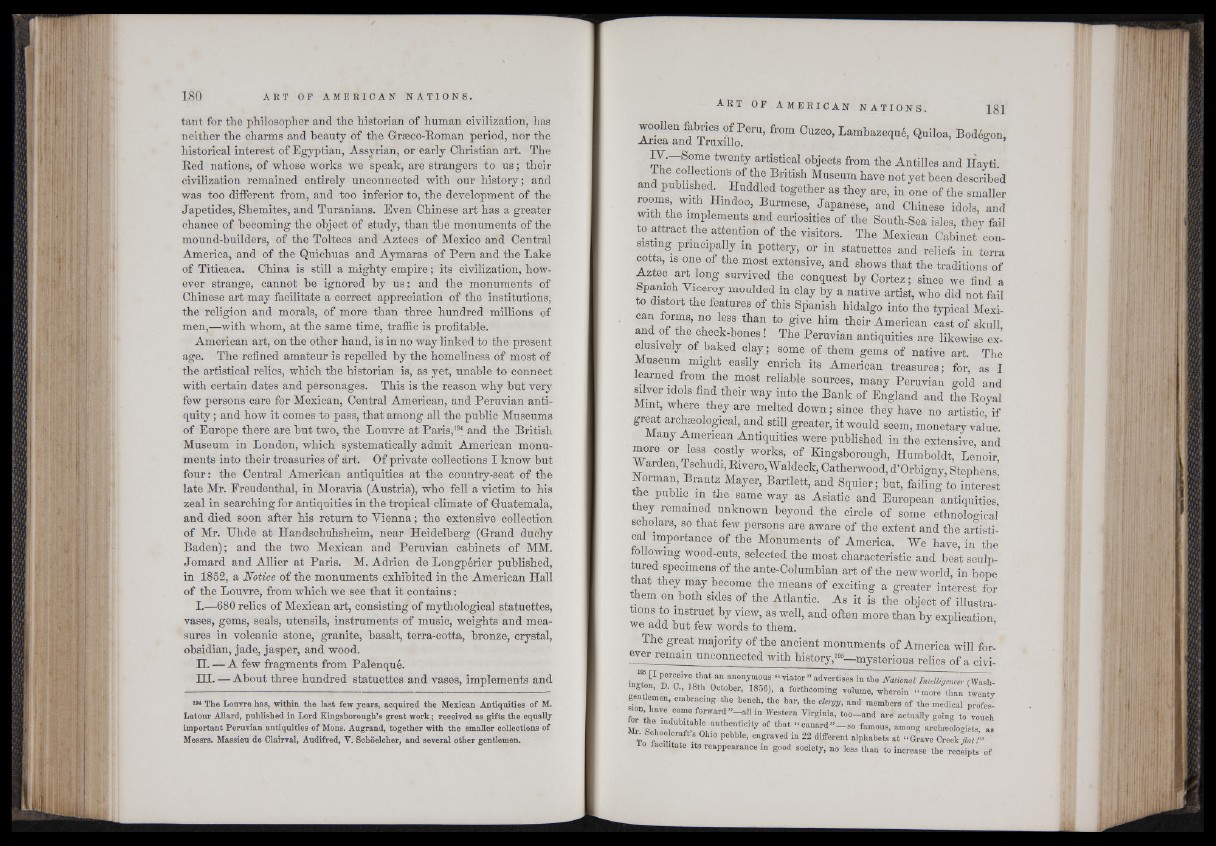
tant for the philosopher and the historian of human civilization, has
neither the charms and beauty of the Grasco-Roman period, nor the
historical interest of Egyptian, Assyrian, or early Christian art. The
Red nations, of whose works we speak, are strangers to u s; their
civilization remained entirely unconnected with our history; and
was too different from, and too inferior to, the development of the
Japetides, Shemites, and Turanians. Even Chinese art has a greater
chance of becoming the object of study, than the monuments of the
mound-builders, of the Toltecs and Aztecs of Mexico and Central
America, and of the Quichuas and Aymaras of Peru and the Lake
of Titicaca. China is still a mighty empire; its civilization, however
strange, cannot he ignored by us; and the monuments of
Chinese art may facilitate a correct appreciation of the institutions,
the religion and morals, of more than three hundred millions of
men,—with whom, at the same time, traffic is profitable.
American art, on the other hand, is in no way linked to the present
age. The refined amateur is repelled by the homeliness of most of
the artistical relics, which the historian is, as yet, unable to connect
with certain dates and personages. This is the reason why hut very
few persons care for Mexican, Central American, and Peruvian antiquity
; and how it comes to pass, that among all the public Museums
of Europe there are hut twt>, the Louvre at Paris,1“ and the British
Museum in London, which systematically admit American monuments
into their treasuries of art. Of private collections I know but
four: the Central American antiquities at the country-seat of the
late Mr. Freudenthal, in Moravia (Austria), who fell a victim to his
zeal in searching for antiquities in the tropical climate of Guatemala,
and died soon after his return to Vienna; the extensive collection
of Mr. Uhde at Handsehuhsheim, near Heidelberg (Grand duchy
Baden) ; and the two Mexican and Peruvian cabinets of MM.
Jomard and Allier at Paris. M. Adrien de Longperier published,
in 1852, a Notice of the monuments exhibited in the American Hall
of the Louvre, from which we see that it contains:
I.—680 relics of Mexican art, consisting of mythological statuettes,
vases, gems, seals, utensils, instruments of music, weights and measures
in volcanic stone, granite, basalt, terra-cotta, bronze, crystal,
obsidian, jade,, jasper, and wood.
H. — A few fragments from Palenque.
HE. — About three hundred statuettes and vases, implements and
1M The Lonvre has, within the last few years, acquired the Mexican Antiquities of M.
Latour Allard, published in Lord Kingsborough’s great work; received as gifts the equally
important Peruvian antiquities of Mons. Augrand, together with the smaller collections of
Messrs. Massieu de Clairval, Audifred, V. Schoelcher, and several other gentlemen.
A R T OF A M E R I C A N N A T I O N S . 181
&°m CW> «M N Bodégon,
IV—Some twenty artistical objects from the Antilles and Hayti.
The j e t i o n s of the British Museum have not yet been described
n published Huddled together as they are, in one of the smaller
rooms with Hindoo, Burmese, Japanese, and Chinese idols, and
with the implements and curiosities of the South-Sea isles, they fail
to attract the attention of the visitors. The Mexican Cabinet consisting
principally in pottery, or in statuettes and reliefs in terra
cotta, is one of the most extensive, and shows that the traditions of
Aztec art long survived the conquest by Cortez; since we find a
Spanish Viceroy moulded m clay by a native artist, who did not fail
to distort the features of this Spanish hidalgo into the typical Mexican
forms, no less than to give him their American cast of skull,
and of the cheek-bones ! The Peruvian antiquities are likewise exclusively
of baked clay; some of them gems of native art. The
Museum might easily enrich its American treasures; for, as I
learned from the most reliable sources, many Peruvian gold and
silver idols find their way into the Bank of England and the Royal
Mint, where they are melted down; since they have no artistic, if
great archaeological, and still greater, it would seem, monetary value
Many American Antiquities were published in the extensive, and
more or less costly works, of Kingsborough, Humboldt, Lenoir,
Warden, Tschudi, Rivero,Waldeck, Catherwood, d’Orbigny, Stephens,
Herman Brantz Mayer, Bartlett, and Squier; but, failing to interest
the public m the same way as Asiatic and European antiquities
they remained unknown beyond the circle of some ethnological
scholars, so that few persons are aware of the extent and the artistical
importance of the Monuments of America. We have, in the
following wood-euts, selected the most characteristic and best sculptured
specimens of the ante-Columbian art of the new world, in hope
that they may become the means of exciting a greater interest for
them on both sides of the Atlantic. As it is the object of illustrations
to instruct by view, as well, and often more than by explication
we add but few words to them.
The great majority of the ancient monuments of America will forever
remain unconnected with history,13*—mysterious relics of a civi-
W n 1"1 “ an0nym0U3 “ Tiator ” advertises in the A'a/ional Inlelligmcer (Washsentle'
. b8r’ 1856)’ a f0rth00ming volume- wherein “ more than twenty
gentlemen, embracing the bench, the bar, the clergy, and members of the medical profes-
emn hare come forward’’- a i l in Western Virginia, too-and are Actually going to vouch
Mr o 6, m, authenticity of that “ canard”—so famous, among archæologiste as
^Schoolcraft s Ohio pebble, engraved in 22 different alphabets at “ Grave Creek flat!”
facilitate its reappearance in good society, no less than to increase the receipts of